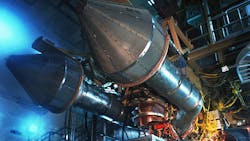According to a joint statement, the U.S. Dept. of Defense and jet-engine builder Pratt & Whitney have agreed to terms for the fifth series of engines for the F-35 Lightning II fighter jets. To date, United Technologies Corp.’s Pratt & Whitney subsidiary has built and supplied 87 production models of its F135 engine, and the new assignment would add 32 more to that total.
The Pentagon’s F-35 Joint Program Office (JPO) and Pratt & Whitney announced that the "agreement in principle" covers 29 engines for three different variants of the F-35 jets, as well as three spare engines.
The financial terms will be announced when the contract is finalized.
Lockheed Martin is the primary contractor for the F-35Lightning II, a single-engine, fifth generation fighter jet with stealth capability, to be used by the U.S. Air Force, U.S. Navy, U.S. Marine Corps, and Great Britain’s Royal Air Force, for ground attack, reconnaissance, and air defense missions. It settled its terms late last year for the fifth round of F-35 production.
"Reaching this agreement is fair and beneficial to the government and Pratt & Whitney," stated Lt. Gen. Chris Bogdan, F-35 program executive officer. "Engine prices have decreased and I appreciate everyone's commitment to drive cost out of the program. This will help us to deliver on the promise of the F-35 to three US services and all the nations partnered with us."
The new deal reportedly covers engineering support, sustainment, and spare parts, as well as the engines.
Lockheed Martin builds the single-engine F-35Lightning II, a fifth-generation jet fighter with stealth capability, to be used by the U.S. Air Force, U.S. Navy, U.S. Marine Corps, and Great Britain’s Royal Air Force, for ground attack, reconnaissance, and air defense missions. Other foreign defense forces involved in the F-35 development include Italy, The Netherlands, Turkey, Canada, Australia, Denmark, and Norway. Purchase contracts for the jets have been reached with Israel and Japan, too.
There are three models of the F-35: the F-35A is a conventional takeoff and landing design; the F-35B is for short take off and vertical landing; and the F-35C is a carrier-based version.
The F135 turbofan engine is the main power plant option for the F-35: it’s an afterburning two-shaft engine, with a three-stage fan (low pressure) and a six-stage high-pressure (HP) compressor. The hot section has an annular combustor with a single-stage HP turbine unit and a two-stage LP turbine. The afterburner has a variable converging-diverging nozzle.
Negotiations between P&W and DoD had been in progress for several months, with the latter seeking a considerable reduction from the amount it paid for the previous production series. One report claimed the Pentagon will pay about $20 million less than the $1.12 billion it agreed to pay for 30 engines when the preliminary contract was agreed in December 2011.
About the Author
Robert Brooks
Content Director
Robert Brooks has been a business-to-business reporter, writer, editor, and columnist for more than 20 years, specializing in the primary metal and basic manufacturing industries.
